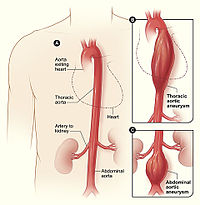
Photo from wikipedia
AIM To estimate undiagnosed aortic stenosis (AS) in the Medicare population. METHODS Patients enrolled (2011-2014) were eligible. After criteria were applied, time zero was the first record of an echocardiogram… Click to show full abstract
AIM To estimate undiagnosed aortic stenosis (AS) in the Medicare population. METHODS Patients enrolled (2011-2014) were eligible. After criteria were applied, time zero was the first record of an echocardiogram (ECHO) for the ECHO-AS cohort and randomly assigned for the no-ECHO cohort. The ECHO-AS cohort was propensity matched to patients in the no-ECHO cohort, and survival analysis was performed. RESULTS Of the 854,493 (25%) patients who received an ECHO, 1 in 4 were diagnosed with AS. After propensity matching, the no-ECHO cohort who died, almost half (49%) had a record of a cardiovascular event prior to their death. The no-ECHO cohort had statistically significant (p = 0.003) higher risk of death than their ECHO-AS counterparts. CONCLUSION In the Medicare population, patients aged 65 years or older, with increased risk factors for and symptoms common in AS patients, should be considered for diagnostic ECHOs.
Journal Title: Journal of comparative effectiveness research
Year Published: 2019
Link to full text (if available)
Share on Social Media: Sign Up to like & get
recommendations!